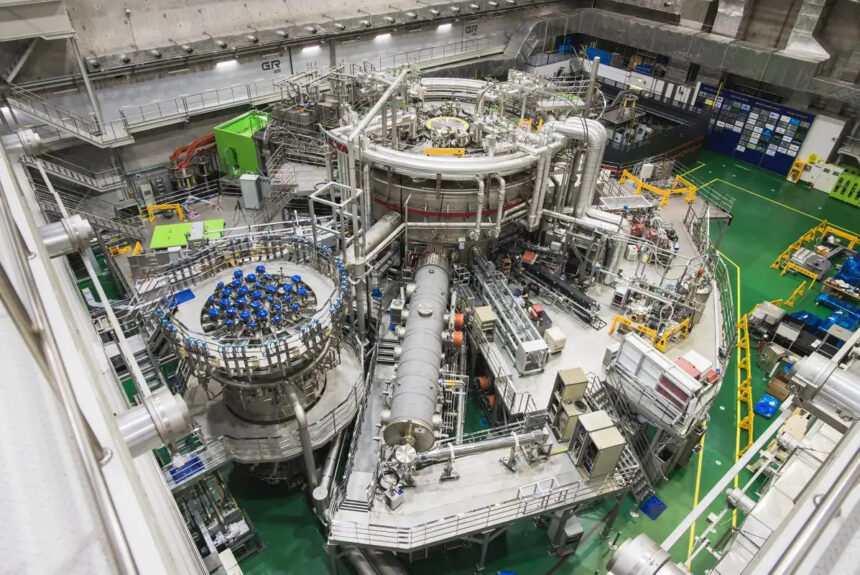After decades of theories and experiments—not to mention public ridicule of the concept—nuclear fusion is close to becoming a reality.
Expert consensus suggests that power plants harnessing this vaunted energy source will operate on electrical grids by 2050, but the United States is woefully unprepared to deploy it on our shores. Only a coordinated “all-in” national nuclear fusion strategy can endow our nation with this potentially transformative solution to our energy and climate challenges.
>>>READ: The UK Forges a Global Path to Nuclear Fusion
American investment in fusion energy dates to the 1950s, and today, DOE allocates $400 million annually for Fusion Energy Sciences to tackle fundamental physics questions. This funding, which constitutes only 15% of the department’s entire R&D budget, fails to meet the level of a dedicated national push to deliver this technology’s promised payoffs. Moreover, the DOE’s multipronged funding approach splits its focus among mutually exclusive efforts, each incapable of delivering a singular fusion reactor design. The recently successful laser-focusing National Ignition Facility is fundamentally different from more common magnetic confinement tokamak ring designs.
DOE’s Fusion Energy Science expects a strong windfall from its participation in the multinational ITER project, but this endeavor will deliver, at best, a proof-of-concept demonstration. Our nation has yet to plan the approach or budget for the vast follow-up efforts to translate this fundamental physics experiment into a watt-producing pilot plant. In fact, the U.S. chose to forgo participation in the ITER Broader Approach Agreement, which would have provided our nation with the project’s pivotal engineering technology necessary for the deployment of fusion energy on the grid. This shortsightedness will significantly devalue the U.S.’s 27-year and $3.9 billion dollar investment into ITER.
While we must optimally capitalize on our 9% stake in this multinational agreement, ITER itself is not free of concern. Project partners include Russia and China, each of which will obtain full access to ITER technical data. China, on its own, has reported several recent fusion breakthroughs and is rapidly catching up to the U.S. In light of geopolitical realities, we must candidly assess whether we can achieve the project’s goals on our own, or restructure the ITER arrangement, without financing other governments’ access to this vast trove of technology.
A national fusion energy strategy needs to both solve the physics and engineering problems and maximize affordability. If thermonuclear power becomes too expensive to integrate into our utilities grid, it will fail. Yet, existing and planned research studies have yet to properly assess the suitability of the U.S. electrical grid of 2050 for a cost-effective implementation of fusion energy. Ongoing initiatives are overemphasizing wind and solar energy for our utilities’ generation mix and, subsequently, deprioritizing the implementation of energy-dense fusion power plants. We will need to tackle reactor cost and grid implementation challenges to prepare the grid for fusion’s arrival. Finally, the U.S. must address its lack of a fusion reactor fuel stockpile, or methods to produce it, that our nation will need to run these power plants.
>>>READ: After Decades of Waiting, Nuclear Fusion is Moving into Full View
Even the most dedicated national efforts cannot overcome roadblocks overnight, and the present-day smattering of government programs hardly rises to the level of a national fusion energy strategy. Presidents and candidates for our nation’s highest office have not set the achievement of this clean power source as their energy or economic agenda centerpiece. Even last year’s fusion research breakthroughs have not spurred a national strategy that capitalizes on successes. While experts reiterated this technology’s importance at the March 2022 White House Fusion Energy Summit, the current Administration has yet to follow through on these discussions. The subsequently enacted Inflation Reduction Act includes only $280 million for fusion energy, while providing $1 billion in loan subsidies for renewable energy and investing $500 million into biofuels.
This means private enterprise will need to play a key role in shaping our nuclear fusion strategy. Dozens of companies have embarked on their own research initiatives, raising almost $4.7 billion in equity. These enterprises are aiming to deliver fusion reactor designs to the grid in the next 20 years. Last year, several U.S. firms reported impressive fusion technology breakthroughs that affirm their footing in this technology space. Ultimately, private companies aim to turn a profit. The solutions that they pursue are, intuitively, most inclined to become cost-effective. If the U.S. sincerely aspires to displace fossil fuels with an energy source that will meet our nation’s demands—rather than settling for a cost-prohibitive lab-bench-scale curiosity—we will need to transition, first the pilot plant design, and then broader on-grid deployment of fusion energy, from government to private hands.
The general public may be excused for skepticism of a technology that has not delivered on its promise after six decades of investment, but policymakers and technology experts should know that keeping nuclear fusion on the backburner can only thwart it from reaching its potential for our nation.
Boris Dyatkin is a materials engineer from Washington, D.C. He is a member of the American Conservation Coalition (ACC).
The views and opinions expressed are those of the author’s and do not necessarily reflect the official policy or position of C3.
